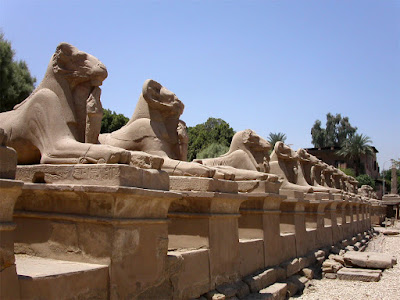The burial temple of Hatshepsut is one of the most dramatic monuments of ancient Egypt. The queen’s architect, Senmut, designed the temple with rows of evenly spaced columns that follow the vertical patterns of the cliff backdrop making the temple a beautiful reflection of its natural surroundings.
Leading up to the temple was a tree lined avenue of sphinxes. There are also a series of walkways connecting a number of terraces built into the temple. The lowest terraces were restored in 1906 to protect the famous reliefs or wall paintings depicting scenes of the temple being built and the birth of the Pharaoh. Although gone today, the front of the upper terrace contained a long line of large statues of the queen that looked out over the valley. When the temple was first built, the walls behind these statues were decorated with bright wall paintings.
Queen Hatshepsut, to whom the temple was dedicated, was one of the first recorded female rulers of ancient Egypt. On her coronation, she wore a complete Pharaoh’s ritual costume including the false beard. We know this from the many wall paintings and statues that depict her as a male; few remaining statues or pictures that show her as a female have survived.
How the great queen Hatshepsut died remains a mystery. Many historians believe that she was killed because she was a woman. After her death in 1452 BCE, Hatshepsut’s name was erased from her monuments and some were destroyed altogether. Still Hatshepsut accomplished what no woman had before her; she successfully ruled the most powerful civilization in the world for over twenty years.
Leading up to the temple was a tree lined avenue of sphinxes. There are also a series of walkways connecting a number of terraces built into the temple. The lowest terraces were restored in 1906 to protect the famous reliefs or wall paintings depicting scenes of the temple being built and the birth of the Pharaoh. Although gone today, the front of the upper terrace contained a long line of large statues of the queen that looked out over the valley. When the temple was first built, the walls behind these statues were decorated with bright wall paintings.
Temple of Hatshepsut
Osiris pillar
From the temple of Hatshepsut
Sanctuary of Hathor
Inside Hatshepsut Temple
Hatshepsut between Re-Horakhty and Amun-Re
Queen Hatshepsut, to whom the temple was dedicated, was one of the first recorded female rulers of ancient Egypt. On her coronation, she wore a complete Pharaoh’s ritual costume including the false beard. We know this from the many wall paintings and statues that depict her as a male; few remaining statues or pictures that show her as a female have survived.
How the great queen Hatshepsut died remains a mystery. Many historians believe that she was killed because she was a woman. After her death in 1452 BCE, Hatshepsut’s name was erased from her monuments and some were destroyed altogether. Still Hatshepsut accomplished what no woman had before her; she successfully ruled the most powerful civilization in the world for over twenty years.

























































